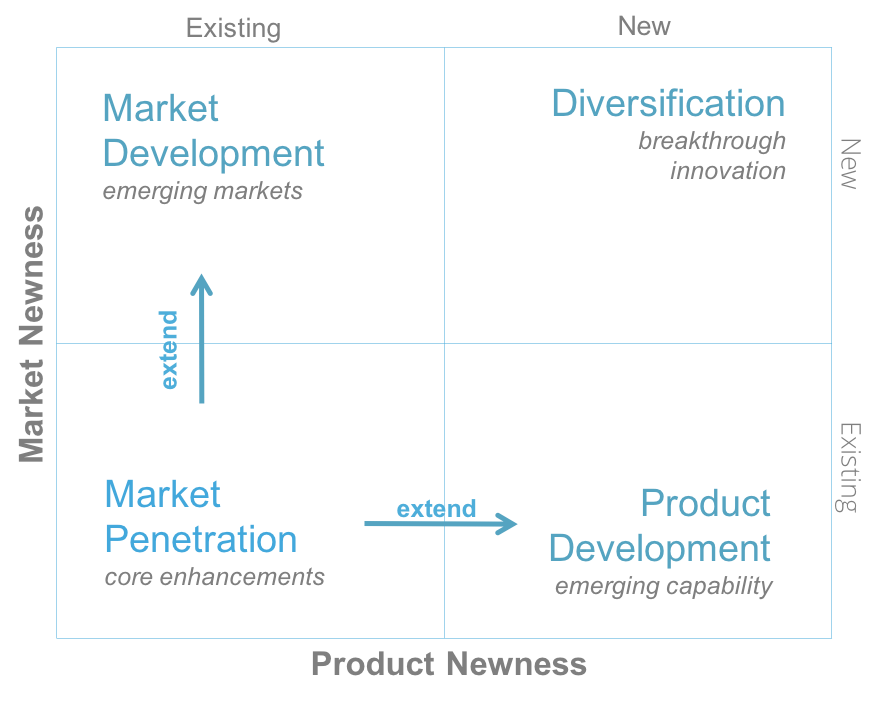What is the Product-Market Matrix?
The Ansoff Product-Market Matrix is a map that helps Product Managers to map strategic market growth. The Ansoff Matrix was named after Igor Ansoff, a mathematician and business manager who published an essay outlining the matrix in the Harvard Business Review in 1957.
The Ansoff Matrix is sometimes referred to as the Product/Market Expansion Grid. The grid breaks down into four possibilities, Market Penetration, Product Development, Market Development, and Diversification. The grid is a 2×2 matrix with two variables on the X-axis (Existing and New Products) and two variables on the Y-axis (Existing and New Markets). It doesn’t matter which order the variables are placed on the grid. Laying it out into a visual grid it helps managers to see potential risks. Each time you move into a new quadrant your risk increases.

Market Penetration
This is the lowest risk of the four quadrants. Market Penetration is working with an existing product in an existing market, to develop a greater Share of Market (SOM). Because of this, the company does not have to venture into new territory and therefore it provides the lowest risk. You can apply new techniques to your existing product in an existing market to increase users or increase user loyalty and/or happiness. This would be things like rewards cards, promotions, an increase in sales or the acquisition of a competitor.
Product Development
Product Development refers to a new product into an existing market. This is considered a higher risk due to varying degrees of diversification. Since your selling a different product to the same people, you can reduce risk by developing related or similar products or you can offer variations to an existing product. You can obtain the acquisition rights to produce someone else’s product as an option.
Market Development
This strategy is targeting news markets with an existing product. This strategy assumes that the existing market has already been exploited to its full extent, therefore you need to enter into a new market for growth. This option is in the lower risk category since the product already exists and research on how to obtain and satisfy customers has already been practiced. Some examples of Market Development include targeting new users in new geographic locations, or different industries or different demographics. Different sales channels are another option. To put it simply, you are repositioning an existing product.
Diversification
This is the riskiest of all four strategies. With Diversification, you are selling a new product to new markets. Diversification requires two-quadrant moves and so it is the riskiest of all four options. There are two types of Diversification, related and unrelated. When practicing related diversification a product is launched in an industry with which it’s familiar. Unrelated diversification is as it sounds, launching a new product into a totally unrelated field. The only way to reduce risk with Diversification is to enter multiple markets at once. By entering multiple markets at once, you can see which market succeeds and then leverage that market, therefore reducing the risk of overall failure.
Advantages and Disadvantages
The Ansoff Matrix is a helpful tool when considering market positioning and growth options. While diversification is seen as the riskiest, it has been said that risk is lowered if a product diversifies successfully into multiple markets. The overall goal of using this matrix is to create a strategic plan for the growth of a product. The challenges of using the Ansoff Matrix is that is doesn’t take into account things like competition in the various markets, the current economy in each market, and flexible structures. With that said, the Ansoff Matrix can help Product Managers to anticipate risks throughout the growth phase of a Product.
In conclusion, using the Ansoff Matrix can’t hurt when developing a new product. It’s always a good idea to evaluate risks and the matrix certainly helps to do that with a simple and easy to view grid. By using the grid you can look at the risks associated with each option and develop a contingency plan for the launch of your new product increasing the odds of success.


